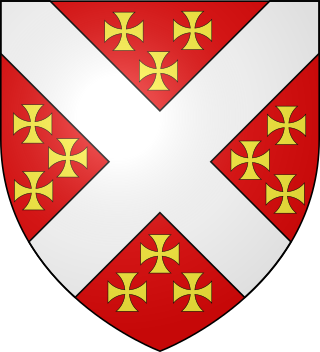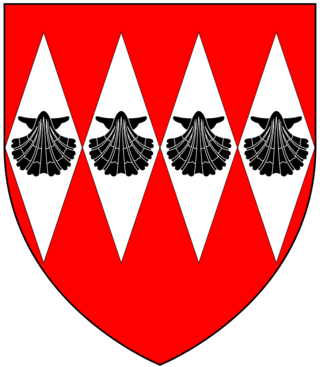
Thomas Walsingham (died 1457) was a wealthy wine and cloth merchant in the City of London who served as a Member of Parliament for Wareham in 1410 and for Lyme Regis in 1413, both in Dorset.

Thomas Walsingham (died 1457) was a wealthy wine and cloth merchant in the City of London who served as a Member of Parliament for Wareham in 1410 and for Lyme Regis in 1413, both in Dorset.
According to Woodger (1993) Walsingham was a son of Alan Walsingham of London, a cordwainer, by his wife Juliana, of unknown family. [2] However, according to the Heraldic Visitations of Surrey, he was the son of Thomas Walsingham by his wife Katherin Belhouse, a sister of Sir William Belhouse. The seat of the Walsingham family in Surrey is not stated. Their earliest recorded ancestor was Sir Richard Walsingham, living in the reign of King Edward I (1272-1307).
He was the supplier of wine to the large household of Cardinal Henry Beaufort (c. 1375–1447), Bishop of Winchester, an influential member of the royal family. [2] He undertook some major building contracts, including glazing the eastern window of the Guildhall in the City of London and creating a conduit to transport drinking water from Paddington to Fleet Street at the western edge of the City of London. [2] He acquired substantial estates in Kent, including the manors of Scadbury (subsequently the seat of his descendants) in the parish of Chislehurst, Champeyns and Tong, and land in Chislehurst, St. Paul's Cray, Lewisham, Bromley and Bexhill. [2]
Some time before 1412 he married Margaret Bamme (died 1445), daughter of Henry Bamme of London, a vintner. By his wife he had one son and one daughter: [2]

Chislehurst is a suburban district of south-east London, England, in the London Borough of Bromley. It lies east of Bromley, south-west of Sidcup and north-west of Orpington, 10 miles (16 km) south-east of Charing Cross. Before the creation of Greater London in 1965, it was in Kent. According to the 2021 census, Chislehurst has a population of 15,600.

Sir Charles Hanbury Williams, KB was a Welsh diplomat, writer and satirist. He was a Member of Parliament from 1734 until his death.
Sir John Guildford, JP, of Hemsted in Benenden, also written Guilford, was an English landowner, administrator and politician.
Sir Thomas Walsingham was a courtier to Queen Elizabeth I and literary patron to such poets as Thomas Watson, Thomas Nashe, George Chapman and Christopher Marlowe. He was related to Elizabeth's spymaster Francis Walsingham and the employer of Marlowe's murderer Ingram Frizer. This connection is one of the reasons offered for suggesting that Marlowe's death may have been linked with intelligence work, and not a dispute over a bill for food and accommodation, as in the coroner's verdict.

Sir Edmund Denny, of Cheshunt was a Tudor courtier and politician. He was a Baron of the Exchequer during the reign of Henry VIII of England.
Sir Thomas Walsingham was an English politician who sat in the House of Commons at various times between 1614 and 1640. He supported the Parliamentarian side in the English Civil War.

Scadbury Park is a Local Nature Reserve in Chislehurst in the London Borough of Bromley. It is also a Site of Metropolitan Importance for Nature Conservation. It is over 300 acres (120 ha), and is part of an extensive wildlife corridor together with Petts Wood and the Jubilee Country Park.

Sir Edmund Walsingham of Scadbury Hall, Chislehurst in Kent, was a soldier, Member of Parliament, and Lieutenant of the Tower of London during the reign of King Henry VIII.
Sir George Gresley, 1st Baronet was an English landowner and politician who sat in the House of Commons from 1628 to 1629.
Sir Richard Osborne, 2nd Baronet, MP was an Irish baronet and politician.

Sir William More, of Loseley, Surrey, was the son of Sir Christopher More. The great house at Loseley Park was built for him, which is still the residence of the More Molyneux family. Of Protestant sympathies, as Sheriff and Vice-Admiral of Surrey he was actively involved in local administration of the county of Surrey and in the enforcement of the Elizabethan religious settlement, and was a member of every Parliament during the reign of Queen Elizabeth I. He was the owner of property in the Blackfriars in which the first and second Blackfriars theatres were erected. He has been described as "the perfect Elizabethan country gentleman" on account of his impeccable character and his assiduity and efficiency of service.
Sir Thomas Pelham, 1st Baronet was an English politician.
Thomas Saunders was an English politician.
Thomas Walsingham was an English politician.

Sir Ralph Cheyne, of Brooke, in the parish of Westbury in Wiltshire, was three times a Member of Parliament for Wiltshire and was Deputy Justiciar of Ireland in 1373 and Lord Chancellor of Ireland 1383–4. He was Deputy Warden of the Cinque Ports.

Lieutenant General Thomas Farrington was a British Army officer and politician who sat in the English and British House of Commons from 1705 to 1712. He raised the 29th (Worcestershire) Regiment of Foot.

John Danvers of Calthorpe, near Banbury and of Prescote in the parish of Cropredy, both in Oxfordshire served four times as a Member of Parliament for Oxfordshire, in 1420, 1421, 1423 and 1435.

Scadbury is a historic manor in the parish of Chislehurst in the London Borough of Bromley, England. Much of the estate is preserved today as Scadbury Park, a 300-acre (120 ha) Local Nature Reserve and a Site of Metropolitan Importance for Nature Conservation. The manorial chapel, known as the Scadbury Chapel, survives in the church of St Nicholas at Chislehurst, and served as a burial place for owners of the estate, including members of the Walsingham family.
Sir George Barne was a prominent merchant and public official from London during the reign of Elizabeth I, and the son of Sir George Barne and Alice Brooke.
Joyce Denny (1507–1560) was an English courtier.